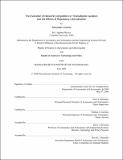| dc.contributor.advisor | Peter P. Belobaba and William S. Swelbar. | en_US |
| dc.contributor.author | Cosmas, Alexander | en_US |
| dc.contributor.other | Massachusetts Institute of Technology. Technology and Policy Program. | en_US |
| dc.date.accessioned | 2009-11-06T14:51:54Z | |
| dc.date.available | 2009-11-06T14:51:54Z | |
| dc.date.copyright | 2009 | en_US |
| dc.date.issued | 2009 | en_US |
| dc.identifier.uri | http://hdl.handle.net/1721.1/49560 | |
| dc.description | Thesis (S.M.)--Massachusetts Institute of Technology, Dept. of Aeronautics and Astronautics; and, (S.M. in Technology and Policy)--Massachusetts Institute of Technology, Engineering Systems Division, Technology and Policy Program, 2009. | en_US |
| dc.description | This electronic version was submitted by the student author. The certified thesis is available in the Institute Archives and Special Collections. | en_US |
| dc.description | Page 150 blank. | en_US |
| dc.description | Includes bibliographical references (p. 147-149). | en_US |
| dc.description.abstract | Since the domestic deregulation of the U.S. airline industry in 1978, impacts to domestic stakeholders, including airlines, airports, labor and consumers, have been well-studied. International air transportation, however, has remained principally regulated by bilateral agreements between governments. Recent global movement towards international deregulation, including the U.S.-EU Open Skies agreement which took effect March 30th 2008, has revived the debate over the effects of regulatory liberalization in aviation. Our research contributes to the debate over regulatory liberalization with an analysis of its impacts in the broader transatlantic market. In this thesis we evaluate how competition in transatlantic aviation markets has evolved over the last decade and how regulatory liberalization has impacted service levels and competition in specific U.S. and European markets. In addition, we explore the extent to which various market characteristics impact transatlantic service levels. This research is conducted in four parts: (1) a stakeholder analysis, (2) a competition and market analysis of transatlantic aviation, (3) a review of the policy impacts since 1990, and (4) an econometric market analysis. In our stakeholder analysis, we find that increased competition is brought about by loosened restrictions on airline networks and by strengthening carriers financially through the availability of foreign capital and opportunities for cross-border mergers. Our market analysis reveals that, in aggregate since 2000, transatlantic markets have seen an increase in number of competitors. | en_US |
| dc.description.abstract | (cont.) In addition, U.S. carriers have gained a disproportionate share of new transatlantic service, leveraging the network effects of flying from their hubs. Further, we discover that although European gateways are highly concentrated to the largest four hubs, overall U.S. gateways are more concentrated than those of Europe, where a greater proportion of traffic is fed through smaller gateways. In our analysis of Open Skies between European countries and the U.S., we find that the agreements have resulted in both increases and decreases in service levels in recent decades. Of the 22 European countries with U.S. Open Skies agreements in place by 2007, only seven demonstrated overall increases in service levels while six demonstrated overall reductions. Five countries saw no significant change and the remaining four have yet to receive direct transatlantic service, supporting our hypothesis that liberalization alone does not oblige service level increases. We discuss the extent to which antitrust immunized alliances in deregulated markets have led to the benefits often credited to liberalization. Our econometric analysis confirms the hypothesis that Open Skies demonstrates no statistically significant correlation to transatlantic service levels. Instead, total economic activity of a city or country and its status as a major carrier hub is the dominant explanatory factor of service levels. | en_US |
| dc.description.statementofresponsibility | by Alexander Cosmas. | en_US |
| dc.format.extent | 150 p. | en_US |
| dc.language.iso | eng | en_US |
| dc.publisher | Massachusetts Institute of Technology | en_US |
| dc.rights | M.I.T. theses are protected by
copyright. They may be viewed from this source for any purpose, but
reproduction or distribution in any format is prohibited without written
permission. See provided URL for inquiries about permission. | en_US |
| dc.rights.uri | http://dspace.mit.edu/handle/1721.1/7582 | en_US |
| dc.subject | Aeronautics and Astronautics. | en_US |
| dc.subject | Technology and Policy Program. | en_US |
| dc.title | The evolution of network competition in transatlantic aviation and the effects of regulatory liberalization | en_US |
| dc.type | Thesis | en_US |
| dc.description.degree | S.M. | en_US |
| dc.contributor.department | Massachusetts Institute of Technology. Department of Aeronautics and Astronautics | |
| dc.contributor.department | Massachusetts Institute of Technology. Engineering Systems Division | |
| dc.contributor.department | Technology and Policy Program | |
| dc.identifier.oclc | 461340377 | en_US |
